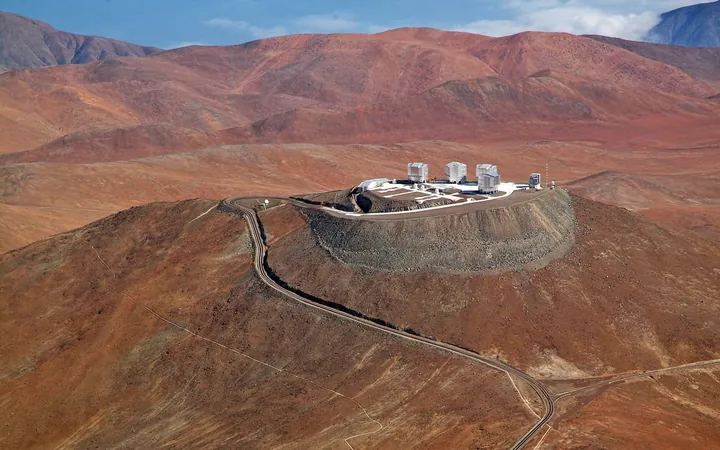
A Looming Industrial Threat: Chile's Astronomical Heritage at Risk from Mega-Project
2025-01-25
Author: Wei
A Looming Industrial Threat
In a shocking turn of events, renowned astronomer María Teresa Ruiz has sounded the alarm over an impending threat to one of the world’s most significant astronomical facilities, the Paranal Observatory, located in the Atacama Desert of Chile. As a progressive eye disease gradually dims her vision, the 78-year-old Ruiz feels an urgent need to protect the legacy of the Paranal, which has been vital to groundbreaking discoveries in the field of astronomy since its opening in 1999.
The Cause of Distress
The cause of her distress? AES Andes, a subsidiary of the American energy giant AES Corporation, has proposed an ambitious industrial complex encompassing over 3,000 hectares just seven miles from Paranal. This planned facility, focused on the generation of electricity from wind and solar power to produce ammonia and green hydrogen, threatens the pristine observation conditions that make Paranal a gold standard for astronomers worldwide. Ruiz poignantly described the anticipated consequences: “Destroying this treasure is a real atrocity, not only for Chile but for all of humanity.”
Astronomical Significance of Atacama
Chile's Atacama region is renowned for having some of the darkest and clearest skies on Earth, essential for astronomical observations. Now, with construction scheduled to begin in 2032, concerns are mounting that the planned industrial activities will severely disrupt the celestial views, undermining decades of scientific investment and discovery. The European Southern Observatory (ESO), which collaborates closely with the Chilean government on myriad research initiatives, has publicly condemned the AES project.
Impact on Scientific Achievements
Since its inception, the Paranal Observatory has been instrumental in various pivotal astrophysics findings, including the first-ever image of an exoplanet and evidence supporting the accelerated expansion of the universe. With facilities like the Very Large Telescope (VLT) and the upcoming Extremely Large Telescope (ELT) on the horizon, the once-quiet desert is poised to become a leading global hub for astronomical research, representing a collective investment from 16 European nations.
Environmental Ramifications
The ramifications of the AES project extend beyond mere visual obstructions. Light pollution and atmospheric disturbances from anticipated construction and operational activities could drastically alter the region's night sky quality. Predictions by ESO scientists indicate that the industrial complex could result in a tripling of the sky's brightness, burdening the observatory with light pollution likely to diminish its classification from 'excellent dark sky' to merely 'rural sky.'
Expert Opinions
Experts in the field, like Fabio Folchi, echo the urgent need for action, asserting, “There is no such thing as friendly light pollution.” This concern is exacerbated by plans for an industrial port, which could increase sky brightness further and entrench environmental degradation.
Regulatory Challenges
Despite the potential disaster, Chile's regulation concerning lighting and environmental protection remains surprisingly lenient. Pedro Sanhueza, former head of sky quality protection, cautioned about the typical lack of permits during construction phases of industrial projects, creating a loophole that could devastate the observatory’s operational capabilities if the AES initiative progresses uninterrupted.
Government Response
In response to this crisis, government officials have initiated an inter-ministerial dialogue involving key ministries to balance energy diversification and scientific preservation in Chile. The Undersecretary of Science, Cristián Cuevas, articulated a hopeful vision of harmonizing energy development with the safeguarding of the night skies, crucial for global astronomical endeavors.
Future Prospects
As the discussion evolves, the Chilean Ministry of Energy has refrained from making definitive statements regarding the AES project while expressing a commitment to the evaluation process. Meanwhile, AES Andes has opted not to provide interviews but asserted a willingness to collaborate with all parties involved in an environmental assessment.
Conclusion
With the future of both Chile’s industrial capability and its astronomical heritage hanging in the balance, the urgency for a transparent dialogue and stricter environmental regulations has never been clearer. The world watches as Chile navigates this challenging crossroads, with the eyes of scientists, enthusiasts, and concerned citizens all turned toward the skies.



 Brasil (PT)
Brasil (PT)
 Canada (EN)
Canada (EN)
 Chile (ES)
Chile (ES)
 Česko (CS)
Česko (CS)
 대한민국 (KO)
대한민국 (KO)
 España (ES)
España (ES)
 France (FR)
France (FR)
 Hong Kong (EN)
Hong Kong (EN)
 Italia (IT)
Italia (IT)
 日本 (JA)
日本 (JA)
 Magyarország (HU)
Magyarország (HU)
 Norge (NO)
Norge (NO)
 Polska (PL)
Polska (PL)
 Schweiz (DE)
Schweiz (DE)
 Singapore (EN)
Singapore (EN)
 Sverige (SV)
Sverige (SV)
 Suomi (FI)
Suomi (FI)
 Türkiye (TR)
Türkiye (TR)
 الإمارات العربية المتحدة (AR)
الإمارات العربية المتحدة (AR)